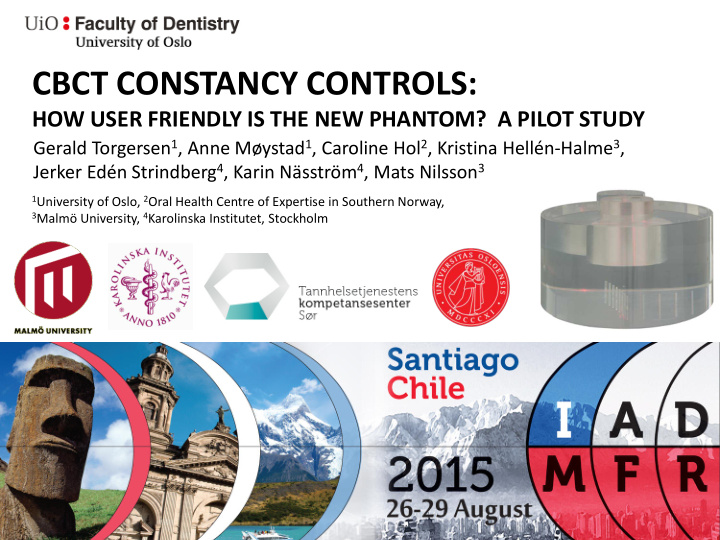



CBCT CONSTANCY CONTROLS: HOW USER FRIENDLY IS THE NEW PHANTOM? A PILOT STUDY Gerald Torgersen 1 , Anne Møystad 1 , Caroline Hol 2 , Kristina Hellén-Halme 3 , Jerker Edén Strindberg 4 , Karin Näsström 4 , Mats Nilsson 3 1 University of Oslo, 2 Oral Health Centre of Expertise in Southern Norway, 3 Malmö University, 4 Karolinska Institutet, Stockholm
Introduction and objectives • Why image quality assurance? • Why constancy controls? • Available equipment and methods – Manufacturer based – Other equipment • Requirements of user-friendliness – The procedure has to be easy – The procedure has to be fast
Introduction and objectives • The objective was to test if the phantom and software are user-friendly tools for Image Quality Assurance (IQA) performed by dental staff. – Can it be done in less than 15 minutes?
The phantom Plexiglas (PMMA) body • Most structures contained in 4 x 4 cm volume • Solid PMMA inset in the second cavity • InsetDiameter phantomDiamet er Axial view cavityHeigth phantomHeight Side view
The Tests • Evaluations – Uniformity (inter/intraslice) – Noise power spectrum – Contrast linearity – Modulation transfer function (MTF) – Geometric linearity • Easy to add other analyses
The software • Based on ImageJ – Free open source image analysis program • Can be run from a USB-stick • Stack loaded automatically • The user has to scroll to slice containing metal beads • Analysis is done automatically
The software Visual control of report:
Equipment and Participants • 4 different CBCT-machines – Instrumentarium OP300 – Planmeca Scanora 3D Mid – Morita Veraviewepocs R100 – Gendex GXCB-500 • 4 Test persons – Specialist in prostodontics – Specialis in maxillofacial radiology – Dental service technician – Dental hygienist
The Study Setup 1. T receives a printed step by step manual 2. The procedure was demonstrated once by P 3. T repeats the procedure twice (1 st and 2 nd run) P = Physicist T = Test person
The Study Setup and Results The procedure steps 1. Phantom placed in FOV 2. FOV adjusted, scout image if available 3. Scan of phantom 4. Export stack to USB-stick 5. Run QA-software 6. Visual control of report Total time for procedure 20 15 CBCT 1 Minutes CBCT 2 10 CBCT 3 CBCT 4 5 0 Physicist Test person 1st run Test person 2nd run
Some observations from test scans 1200 HU values of different materials 1000 800 CBCT 1 600 CBCT 2 400 CBCT 3 200 CBCT 4 0 Nominal -200 -400 Nylon Polyethen Teflon Acetal PMMA -600 Uniform plexiglass - 5 ROI's average 300 200 100 Mean HU value 0 -100 -200 -300 -400 Errorbars represent ± 1 StDev -500 CBCT 1 CBCT 2 CBCT 3 CBCT 4
Conclusions • The whole procedure can be done in less than 15 minutes and the training requirements are minimal. • The presented phantom is user-friendly and can be used by clinical staff to perform constancy IQA. • With adequate tools IQA can be performed regularly and easily
Thank you for your attention Photo: IADMFR 2013 - Bergen, Norway View from the Fløyen mountain
References The phantom Torgersen et al. (2014). A phantom for simplified image quality control of dental cone • beam computed tomography units. Oral Surg Oral Med Oral Pathol Oral Radiol Endod . 118 (5), s 603- 611 . doi:10.1016/j.oooo.2014.08.003 Our institutions Karolinska Institutet, Stockholm, Sweden • Malmö University, Malmö, Sweden • Oral Health Centre of Expertise in Southern Norway (Norwegian only) • Faculty of dentistry, University of Oslo, Norway • ImageJ ImageJ home: http://imagej.nih.gov/ij/ • Fiji version of ImageJ used in pilot: http://fiji.sc/Fiji • Contact: http://www.odont.uio.no/english/people/adm/fac/gerald
Recommend
More recommend